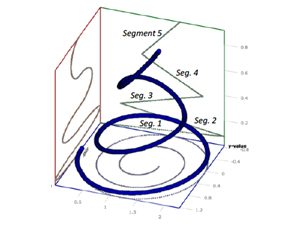
Multi-disciplinary engineering faculty look to develop device to minimize damage to ear while maximizing amount of sound available to hearing impaired
In-Ho Cho makes a spiral motion with his hand, demonstrating the coiled shape of the human ear’s cochlear structure. Located inside the inner ear, the cochlear structure is critical to a person’s hearing ability.
“It is a very thin structure and very sensitive. Once it is cracked, it is permanently damaged. It will be damaged forever. It causes pain to the patient and hearing capability deteriorates,” Cho says.
The project
Cho is an assistant professor in the department of civil, construction and environmental engineering and the co-principal investigator for the project “Development of spirally coiling, force-sensing soft-robot for safe and accurate cochlear electrode implementation.” The research is funded by a $300,000 grant from the National Science Foundation.
Cho is collaborating with Associate Professor Jaeyoun Kim of electrical and computer engineering, who is serving as the principal investigator for the project.
A painful problem
In their abstract, the faculty members write that cochlear implants, or CIs, are becoming the main way to solve a number of hearing difficulties.
Cho describes the current methods used to correct problems with the cochlear structure. Doctors insert hard rubber hearing devices into a patient’s ear, turning the device to obtain the correct position. Even with the best medical precision, inner ear structures are sometimes torn. At best, the implanted device only achieves about 1.5 turns within the cochlear, while a 2.5-turn insertion is vital for maximum efficiency.
“The challenge is, how can we minimize damage to the human cochlear structure while reaching that deep inside the cochlear?” Cho asks.
Finding a cure
Cho and Kim are suggesting a different approach. They want to develop a softer, smaller micro-robotic device in which a CI electrode array is embedded to mimic the electrical signals with which a cochlear structure communicates with the human nervous system. By a full 2.5-turn insertion, the patient’s nervous system will receive wider frequencies.
Cho, who specializes in structural engineering with an emphasis in computational statistics and machine learning, will use both machine and statistical learning to explore the vast array of possibilities for the new device structures.
“Millions of combinations or parameters will generate for cochlear structures,” Cho says of the process. “Among them, which ones are most fit for each patient’s structure with least damage?”
Cho will need to solve that question, along with how he will achieve a comfortable amount of “hugging” (how the implant grips the structures surrounding it when placed inside a patient’s inner ear). Kim will then work to develop the device, as well as the method for inserting the CI electrode array into each device.
“This will lead to a very efficient and cheap medical device in comparison to traditional devices … It will greatly improve the performance of the medical device and it will help the medical community because it will ease the surgical procedure,” Cho says.
This project started in September and will continue through August 2019. During this semester, Cho’s doctoral student Ya Lu Teng is supported by this grant.
